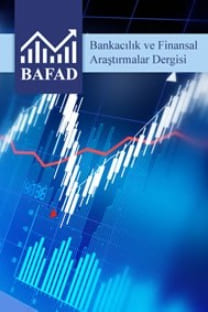Türkiye’de Para Politikası Gecikmeleri Üzerine Deneysel Bir Analiz: 2003-2020 Dönemi
Para politikası gecikmeleri, merkez bankası politikalarının ekonomiye aktarım süresini gösterdiğinden son derece önemlidir. Literatürde Friedman’ın (1961, 1972) çalışmalarından hareketle, genel olarak bu aktarımın uzun ve değişken gecikmelerle mümkün olduğu görüşü hakimdir. Aktarım süresi hedef değişkenlerin niteliğine ve araç değişkenlerin türüne göre değişebilmektedir. Bu çalışmada, 2003 sonrası dönemde Türkiye’de para politikası gecikmelerinin ortalama uzunluklarının belirlenmesi amaçlanmıştır. Fiyat istikrarı, ekonomik faaliyet hacmi ve finansal istikrarı temsil eden hedef değişkenlerin para arzı ve merkez bankası politika oranındaki değişimlerden ne kadar sürede etkilendikleri araştırılmıştır. Ayrıca sosyal medya kullanımı ve güçlü ekonomik etkileri olabilecek şoklar da kukla değişkenler olarak modellere dahil edilmiştir. Böylece politikalara ilişkin haberlerin yayılma hızı ve şokların gecikmeler üzerinde etkileri olup olmadığı sorgulanmıştır. Analizlerde dağıtılmış gecikme modelleri ve ardışık bağlanımlı regresyon modeli kullanılmıştır. Elde edilen bulgular, politika değişmelerinin enflasyonu 22 ay, ekonomik faaliyet hacmini 20 ila 24 ay civarında etkilediğini göstermiştir. Finansal istikrarı temsil eden kredi açığı, politika değişimlerinden 12 ay gibi nispeten kısa bir zamanda etkilenmektedir. Kukla değişkenlerin gecikme uzunlukları ve bağımlı değişkenler üzerinde anlamlı bir etkileri olduğu belirlenememiştir. Enflasyonun ve ekonomik faaliyet hacmini yansıtan alternatif değişkenlerin güçlü bir şekilde geçmişe bağlılıkları olduğu gözlemlenmiştir.
An Empirical Analysis on Monetary Policy Lags in Turkey: 2003-2020 Period
Monetary policy lags are very important, as they indicate the transmission time of central bank policies to the economy. Since the studies of Friedman (1961, 1972) are taken as a basis in the literature, it is generally believed that this transmission time is possible with long and variable lags. Transmission time may vary depending on the nature of the target variables and the type of instrument variables. In this study, aimed to determine the average length of lag in monetary policy in the post-2003 period in Turkey. It has been studied how long the target variables representing price stability, volume of economic activity and financial stability are affected by the changes in money supply and central bank policy rate. In addition, the use of social media and shocks that may have strong economic effects are included in the models as dummy variables. Thus, the speed of propagation of news on policy changes and whether shocks have an impact on the lags was investigated. In the analyzes, distributed lag models and autorregressive regression model were used. Findings show that policy changes affect inflation 22 months later, and economic activity around 20 to 24 months. The credit gap, which represents financial stability, is affected by policy changes in a relatively short time, i.e. 12 months. It could not be determined that dummy variables have a significant effect on lag lengths and dependent variables. It has been observed that inflation and the alternative variables reflecting volume of economic activity are strongly dependence to the past.
Keywords:
Monetary policy, policy lags distributed lag models,
___
Asghar, N., ve Hussain, Z. (2014). The lags in effect of monetary policy: A case study of Pakistan. Pakistan Economic and Social Review, 52(1), 1-14.Batini, N., ve Nelson, E. (2001). The lag from monetary policy actions to inflation: Friedman revisited. International Finance, 4(3), 381-400.
Batini, N., ve Nelson, E. (2001). The lag from monetary policy actions to inflation: Friedman revisited. Bank of England, External MPC Unit Discussion Papers, No. 6, January.
Bernanke, B. S., Laubach, T., Mishkin, F. S., ve Posen, A. S. (1999). Inflation targeting: Lessons from the international experience, Princeton University Press, Princeton, New Jersey.
Flamini, A. (2012). Transmission lags and optimal monetary policy. University of Pavia, Department of Economics and Quantitative Methods Working Papers, No. 166, February.
Friedman, M. (1961). The lag in effect of monetary policy. Journal of Political Economy, 69(5), 447-466.
Friedman, M. (1972). Have monetary policies failed? The American Economic Review, 62 (1/2), 11-18.
Gruen, D., Romalis, J., ve Chandra, N. (1997). The lags of monetary policy. Reserve Bank of Australia, Research Discussion Papers, No. 9702, April.
Gruen, D., Romalis, J., ve Chandra, N. (1999). The lags of monetary policy. The Economic Record, 75(230), 280-294.
Ha, Y. (2000). Uncertainty about the length of the monetary policy transmission lag: Implications for monetary policy. Reserve Bank of New Zealand Discussion Papers, No. DP2000/01, February.
Havranek, T., ve Rusnak, M. (2013). Transmission lags of monetary policy: A meta-analysis. International Journal of Central Banking, 9(4), 39-75.
Kilponen, J., ve Leitemo, K. (2011). Transmission lags and optimal monetary policy. Journal of Economic Dynamics and Control, 35, 565-578.
Labonte, M. (2020). Monetary policy and the Federal Reserve: Current policy and conditions. Congressional Research Service, No. RL30354, February, 6.
Nishiyama, S.I. (2009). Monetary policy lag, zero lower bound, and inflation targeting. Bank of Canada Working Papers, No. 2009-2, January.
Petursson, T. G. (2001). The transmission mechanism of monetary policy. Central Bank of Iceland, Monetary Bulletin, 3(4), 62-77.
Tanner, E. (1979). Are the lags in the effects of monetary policy variable? Journal of Monetary Economics, 5, 105-121.
- ISSN: 2148-4090
- Yayın Aralığı: Yılda 2 Sayı
- Başlangıç: 2014
- Yayıncı: Ankara Hacı Bayram Veli Üniversitesi
